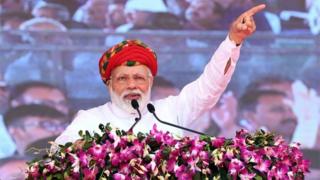India announces general election dates
India’s general election will take place in seven phases between April and May, the Election Commission says.
Polls to elect a new Lok Sabha, or lower house of parliament, will be held from 11 April to 19 May. Votes will be counted on 23 May.
With 900 million eligible voters, India’s election will be the largest the world has seen.
PM Narendra Modi’s ruling BJP will be battling the main opposition Congress and a host of regional parties.
Leaders of two powerful regional rivals have formed a coalition against the BJP in Uttar Pradesh, India’s most populous state, and a key bellwether state.
The lower house has 543 elected seats and any party or coalition needs a minimum of 272 MPs to form a government.
So what makes these elections distinctive?
1. It’s mind-bogglingly big
Everything about Indian general elections is colossal – the Economist magazine once compared it to a “lumbering elephant embarking on an epic trek”.
This time, more than 900 million people above the age of 18 are expected to cast their ballots at a million polling stations.
The number of voters is bigger the population of Europe and Australia combined.
Indians are enthusiastic voters – the turnout in the last general election in 2014 was more than 66%, up from 45% in 1951 when the first election was held.
More than 8,250 candidates representing 464 parties contested the 2014 elections, nearly a seven-fold increase from the first election.
2. It takes a long, long time
The dates on which voting will be held are 11 April, 18 April, 23 April, 29 April, 6 May, 12 May and 19 May.
Some states will hold polls in several phases.
India’s historic first election in 1951-52 took three months to complete. Between 1962 and 1989, elections were completed in four to 10 days. The four-day elections in 1980 were the country’s shortest ever.
Source: Read Full Article



